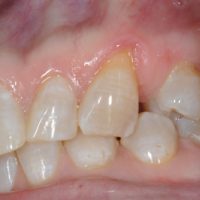The tunneling procedure, performed by a Periodontist, for connective tissue grafting is very effective for covering tooth root surfaces that have been exposed due to gingival recession. Not only does it result in a very cosmetic result, but it also increases the amount of attached gingiva and is very stable for the long term.
The technique involves dissecting the gingiva away from the underlying bone and tooth root surface. This creates a space or tunnel in which connective tissue from the roof of the mouth can be transplanted. Prior to placing the tissue, the root surface is prepared by scaling and root planing. Once the graft is in place the gingiva is sutured into position over the graft.
The results are apparent at one week. There are variations for this technique. As opposed to harvesting tissue from the roof of the mouth, cadaver tissue, like Alloderm, can be used. I have found the results more consistent using the patients own tissue rather than the Alloderm. However when it is necessary to graft multiple teeth using the Alloderm makes for a much easier post operative recovery as most of the post operative discomfort results from the donor site on the roof of the mouth. Here is an example of a case using Alloderm. Other variations involve root surfaces treatments such as Emdogain, which is a protein gel that is applied to the root surface prior to graft placement.
As a generalization, for localized procedures 1-3 teeth I prefer to use the patients own connective tissue harvested from the palate (roof of the mouth). For larger cases I prefer using Alloderm. When palatal tissue is used, a palatal stint is made which covers the roof of the mouth. and is worn during the first week of healing. It protects and insulates the wound and is very helpful in controlling the discomfort that results from the donor site on the roof of the mouth.



the of these dental defect are very nice i would like to ask what is the percentage of the success with my regardes
Very high. I have gone back to mostly using tissue from the roof of the mouth vs Alloderm.